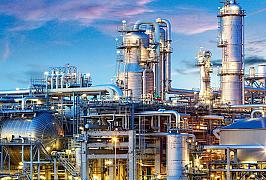
STATE OF THE ART LEVEL MEASUREMENT TECHNOLOGY
The perfect measurement solution!
Level measurements under extreme conditions can only be done with the help of radiometric measurement technology, which has been tried and tested for more than 70 years - a technology invented by Berthold. Externally applied gamma radiation penetrates thereby the measuring vessel and this is weakened depending on the vessel level. A detector located on the opposite side of the vessel measures the incoming radiation and can determine the level very accurately from the radiation attenuation. This level value is displayed either directly on site or integrated in a PLC or process control system. Berthold is unique in the specialization in contactless measurements in the process industry worldwide.
Quality and safety
- 70 years of experience of the world market leader in radiometric level measurement technology ensure your project success
- Accurate and reliable
- No wear and tear
- Worldwide service and support
Simple and intuitive operation
- Maintenance-free
- Not influenced by temperature, pressure, dust, colour, conductivity or chemical product properties
- Universally applicable for all vessel types, no system modification required
VARIOUS ARRANGEMENTS FOR YOUR LEVEL MEASUREMENT TASK
Customized solutions for level measurement which ideally comply with the existing requirements may be achieved by using various detectors and sources. They can be combined in various ways and may also be inserted in dip pipes. Which of these possibilities is selected depends on the measurement geometry, accuracy requirements and the economic aspects.
COMPONENTS USED FOR LEVEL MEASUREMENT PURPOSES
Point sources
Point sources are widely used in literally any measurement task, whether it is density, level or the use as limit switch. They usually comprise an inner source capsule, which securely encapsulates the radioactive material and a shield with a shutter mechanism to block the radiation in a controlled way. More information
Rod sources
A rod source is a device where the active area is continuously distributed over the complete measuring range. This can be done by winding an activated Cobalt wire (Co-60) on a carrier. One of the benefits of a rod source is, that a “perfectly” linear calibration of the detected signal (count rate vs. level %) can be achieved, meaning the percent change of the count rate is direct related to the percent change of the process value. More information
Point detectors
Detectors with a small scintillator are called point detectors. They often employ a small cylinder as scintillator, e.g. 50 mm diameter and 50 mm in height. They are typically used for density applications but also for level switch or continuous level measurements. Depending on the measurement task, other scintillator sizes may be used. Due to the small sensitive volume of a point detector it is not greatly affected from background radiation. Additionally, point detectors can be easily equipped with a lead collimator to further suppress sensitivity to background radiation.
Rod detectors
In some cases, it is beneficial to have the scintillator covering a longer range, this is called a rod detector. Typically, in level measurements either source or detector span over the whole measuring range. Their length can be up to 8 m. The main benefit of a rod detector is its lower cost compared to a rod source. Albeit, the rod source would be the technologically superior system. The gamma radiation which a rod detector is able to detect, is influenced by the geometry of the radiation array. However, as rod detectors are typically not shielded (and a shield would diminish the cost advantage) they are much more sensitive for changes in natural background radiation making this effect dominant to most other errors. Particularly, taking into mind that fluctuations of ± 15 % i.e. through accumulation of Radon-222 and its decay products, e.g. after rain, are possible, which we will demonstrate later on.

